The updated digitalEPIGRAPHY website – An Epigraphic Survey, Harvard University, and KU Leuven Collaboration
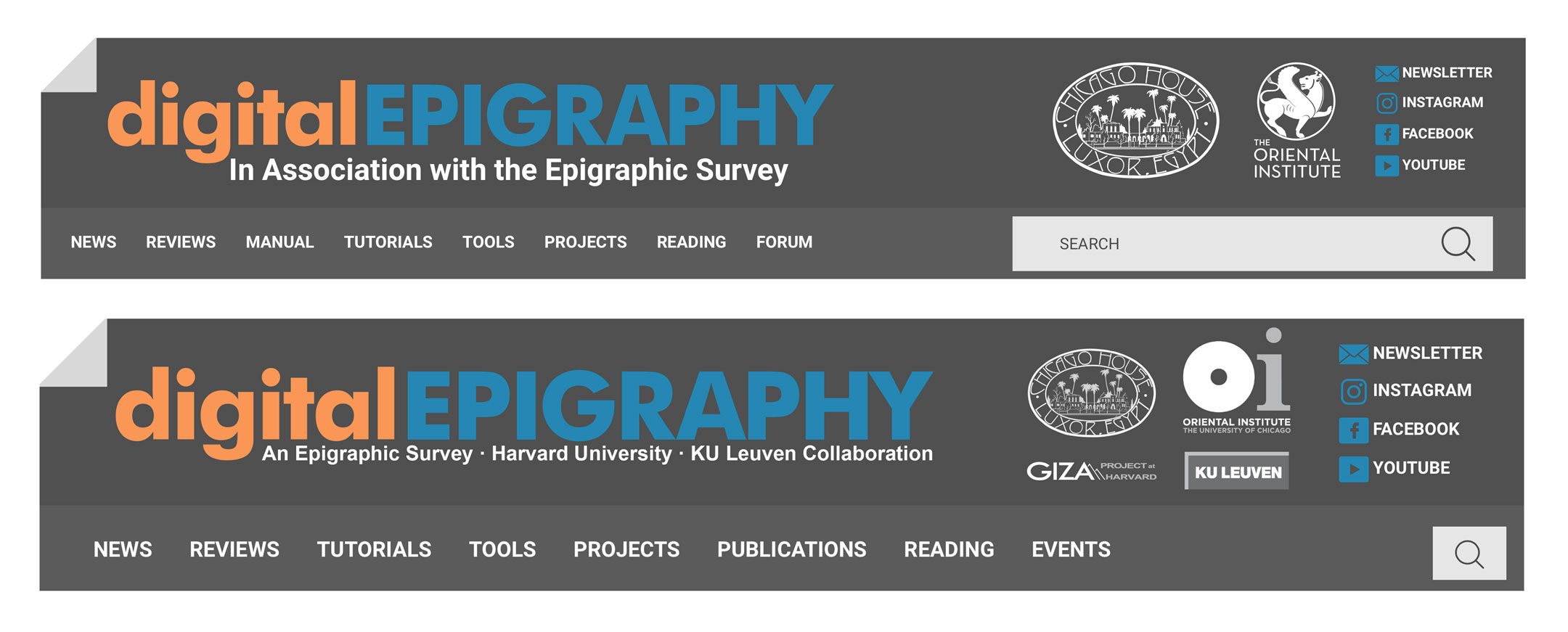
Same but (slightly) different – the renewed digitalEPIGRAPHY website retains its clean interface and visual structure
Dear Readers,
A lot has happened since the digitalEPIGRAPHY website replaced the Epigraphic Survey's Digital Epigraphy Manual in 2018. In the past two years, we've been expanding our scope, tirelessly adding new content upon what was available in the original Manual, opening new frontiers of interest, and taking the art of digital documentation in unexpected and exciting new directions. I would like to thank you all for your overwhelming support for what we do and what digitalEPIGRAPHY stands for!
First and foremost, I have the great pleasure to announce that some of this encouragement resulted in a collaboration we've never dreamt of! I would like to welcome Peter Der Manuelian (Giza Project at Harvard) and Marleen De Meyer (KU Leuven) as our website's newest contributors and devoted supporters. The Epigraphic Survey has always considered digitalEPIGRAPHY to be an ever-changing, "work in progress" effort, as Survey Director, W. Raymond Johnson wrote in his Foreword back in 2018. The general philosophy behind our site won't change much as we continue presenting relevant news, reviews, tutorials, and case studies from the world of digital documentation. Nonetheless, we genuinely believe that with the involvement of Harvard University and KU Leuven, we won't only be able to reach a broader audience but serve our devoted readers with a greater variety of topics, specifically tailored to everyone's needs. To facilitate more of these fundamental elements, we went back to the drawing table (no pun intended!) and redesigned some of the site's structural components. The website Header was updated to reflect our new partnership with Harvard University and KU Leuven and the new logo of our mothership, the Oriental Institute. The greyscale variants of the logos aren't for display only but also function as gateways to our partner sites' home pages. On the far right, you'll find quick links to sign up to our periodical Newsletter, check out and follow our Instagram and/or Facebook feed or watch/subscribe to our tutorials accessible through YouTube.
There are further changes regarding the main Menu as well. When you look at the new menu items, you might wonder where the Digital Epigraphy Manual has gone? It is not missing but can be found in the new Publications section now. Another missing category is Forum that was moved from the Header and can be directly accessed from the Footer now. As you scroll all the way down on an article page, you'll find the usual panel to leave a comment, subscribe to our Newsletter, access all the TAGS relevant to an article, or follow up on the discussion regarding our "hot" topics in the Forum. Just a reminder: you can click on any tags to access all articles with the same label. Also, all available cards can be displayed by clicking on the TAGS button at the Footer section.
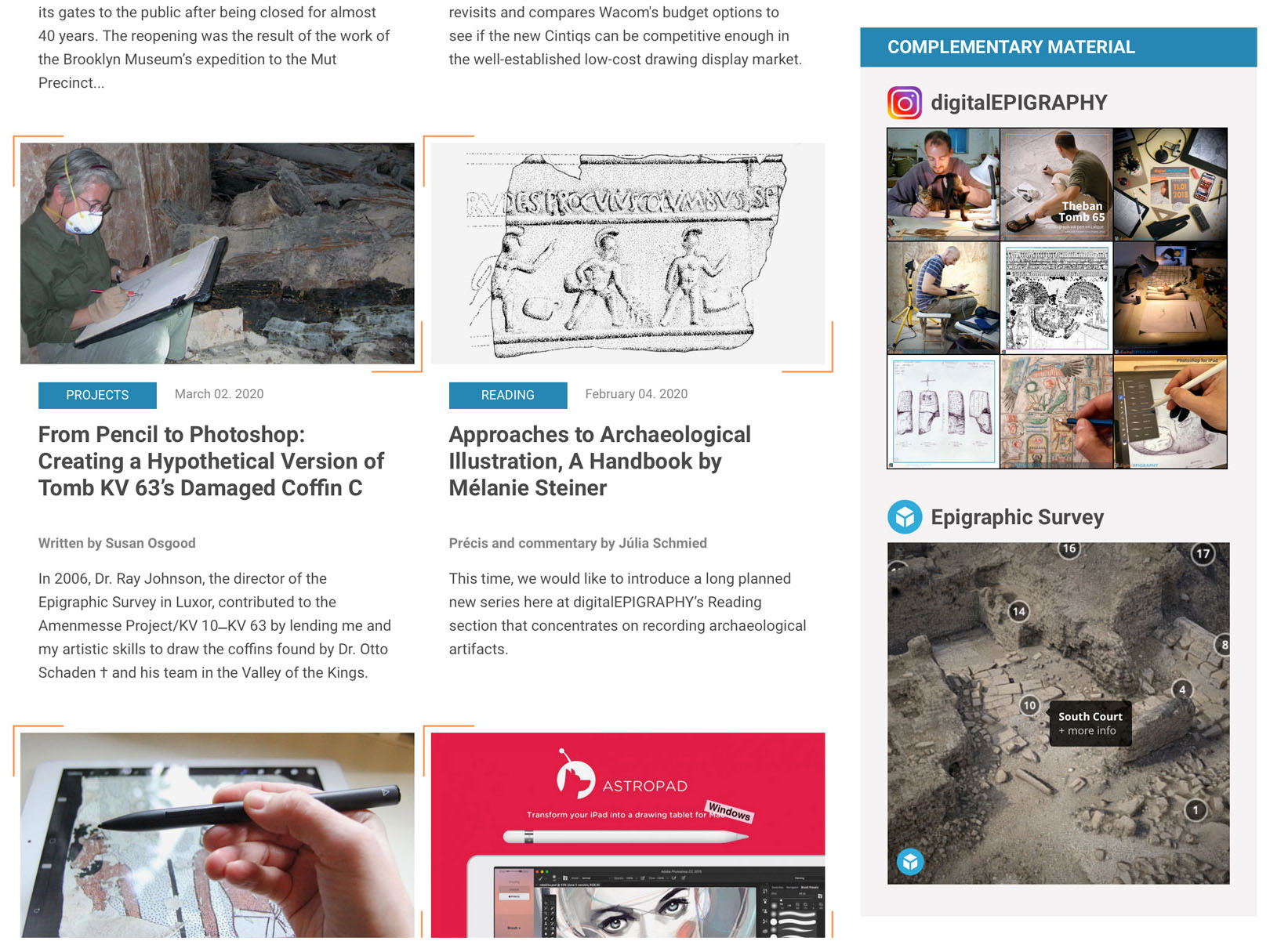
The Manual was moved to the Publications section, creating some space on the right for our new Instagram and SketchFab feeds
There are several changes and new additions to the homepage. On the right, where a random selection of the Manual's chapters used to be on display, we created a new and exciting block called Complementary Material. Both of the components already available of this vertical area are essentially square windows designed to provide quick visual access to digitalEPIGRAPHY's Instagram account and the Survey's SketchFab platform. With our brand-new Instagram presence, we hope to promote our epigraphic methods in a visual form one photo at a time. Naturally, you'll always find the latest Instagram photos on our homepage by clicking on the thumbnail images that will take you directly to the post. If you'd like to have a look at what else we posted on Instagram, just click on the title above the window to be taken directly to digitalEPIGRAPHY's Instagram page.
SketchFab, with a community of millions of creators, is the largest platform for immersive and interactive 3D models. As the Epigraphic Survey evolves, more and more of these 3D visualizations of our sites and projects become available. With our ever-changing window to this exciting 3D site, digitalEPIGRAPHY would like to recognize the work Survey members do to record the immense data provided by ancient landscapes, be it a site survey, a wall fragment, or an interesting object. You can interact with the model within the display window by dragging it around, zooming in and out or clicking on the numbers for additional information. If you'd like to know more about the model on display, click on the SketchFab icon inside the window. In case you'd like to see all the models created by the Survey, you can do so by clicking on the title above the window.
Below the Complementary Material, you'll find two lists with quick, direct links to our latest Reviews and Tutorials, two categories that generate the most interest among our readers. We thought hard about how to give you the same reading experience on your mobile devices. In the end, we decided to maximize the news feed in the usual three Spotlight articles and five further articles from our latest news feed to make room for the Complementary Material at the bottom. We recommend scrolling all the way through the beautiful responsive rendering of the digitalEPIGRAPHY website, now available in all its richness in your pocket!
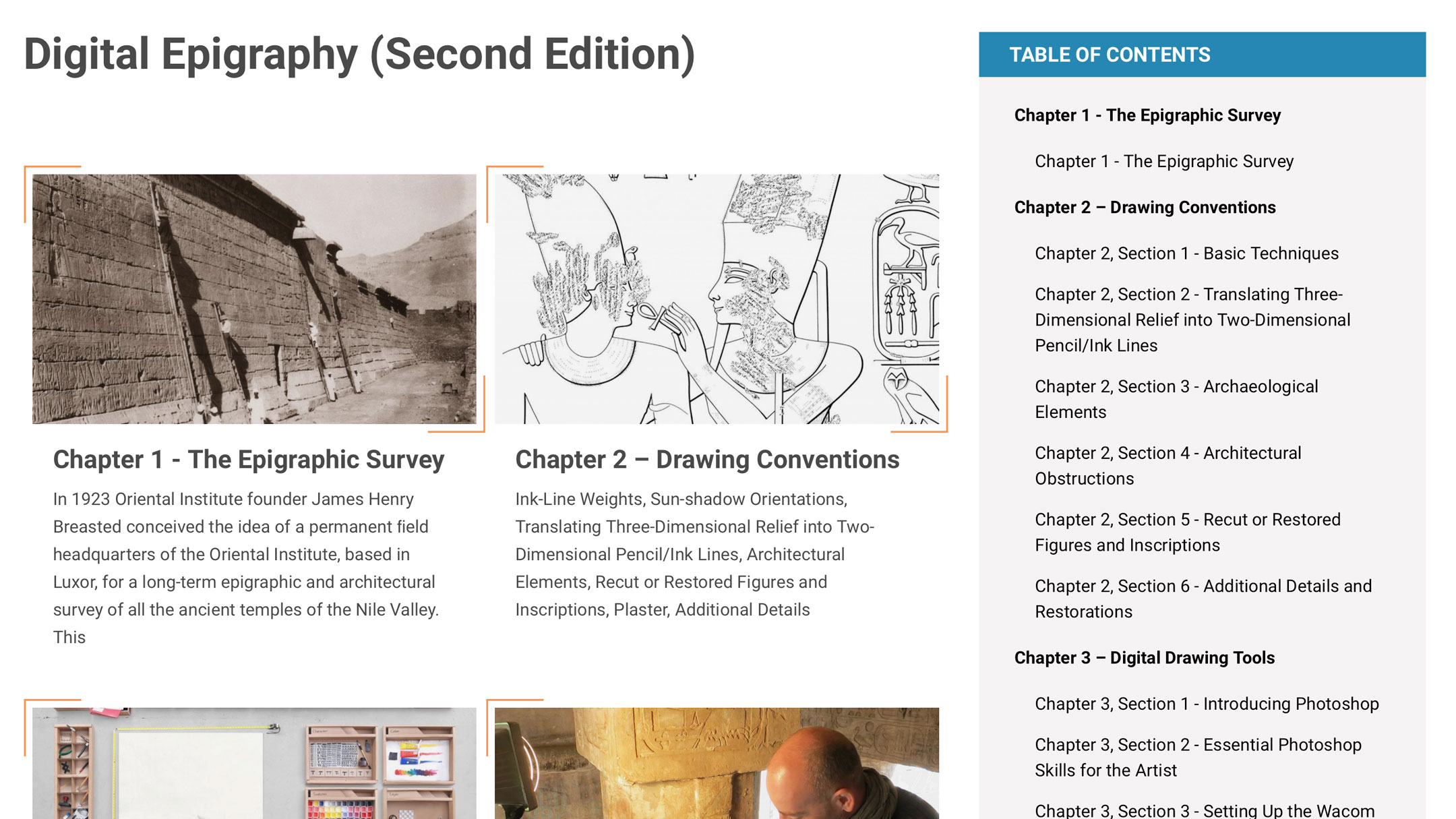
Upon opening a digital publication, you'll find its interactive Table of Contents on the right
One of the new and exciting ways we'd like to realize our collaboration with the Giza Project at Harvard University is by digitally resurrecting/updating old publications containing a significant amount of epigraphic information. We are testing this idea by taking one of the well-known volumes of the Giza Mastaba Series to produce a chapter-by-chapter web version of the book. It is planned to be extended with enhanced bibliography, updated references, drawings, photos, additional 3D models, etc., all (re)published through the digitalEPIGRAPHY website. To make room for such digital publications, we created an entirely new Menu for digital books called Publications, with our Digital Epigraphy manual being the first in the row. The prospect of digital publishing is tremendously exciting for us, and we can't wait to see this space populated by such material.
When you look at the Manual now, you can already see some welcome changes as we added the Table of Contents on the right (replacing the Latest Publication segment as you click on the Publications Menu), helping navigation within the book you're reading. The Table of Contents area is entirely interactive, highlighting the Chapter/Sub-Chapter you're in and showing you relevant information about what else is in that chapter. You can instantly switch to a new segment of the book by clicking on any parts of the Table of Contents. This is going to be a real time-saver once we offer more and more digital publications for you, we hope you'll like it as much as we do.
Last on the list of changes is Events, replacing the Forum among the menu items. It is a dedicated space reserved for all happenings (workshops, conferences, lectures, etc.) related to the website's educational activity. You'll see it filled with past and future events as we go, and you'll be able to express your interest in being a part of our educational hub by checking back here often. We are reserving the possibility of holding online epigraphy courses in the future, and the new Events section seems to be the perfect place to accommodate these efforts. So, watch that space!
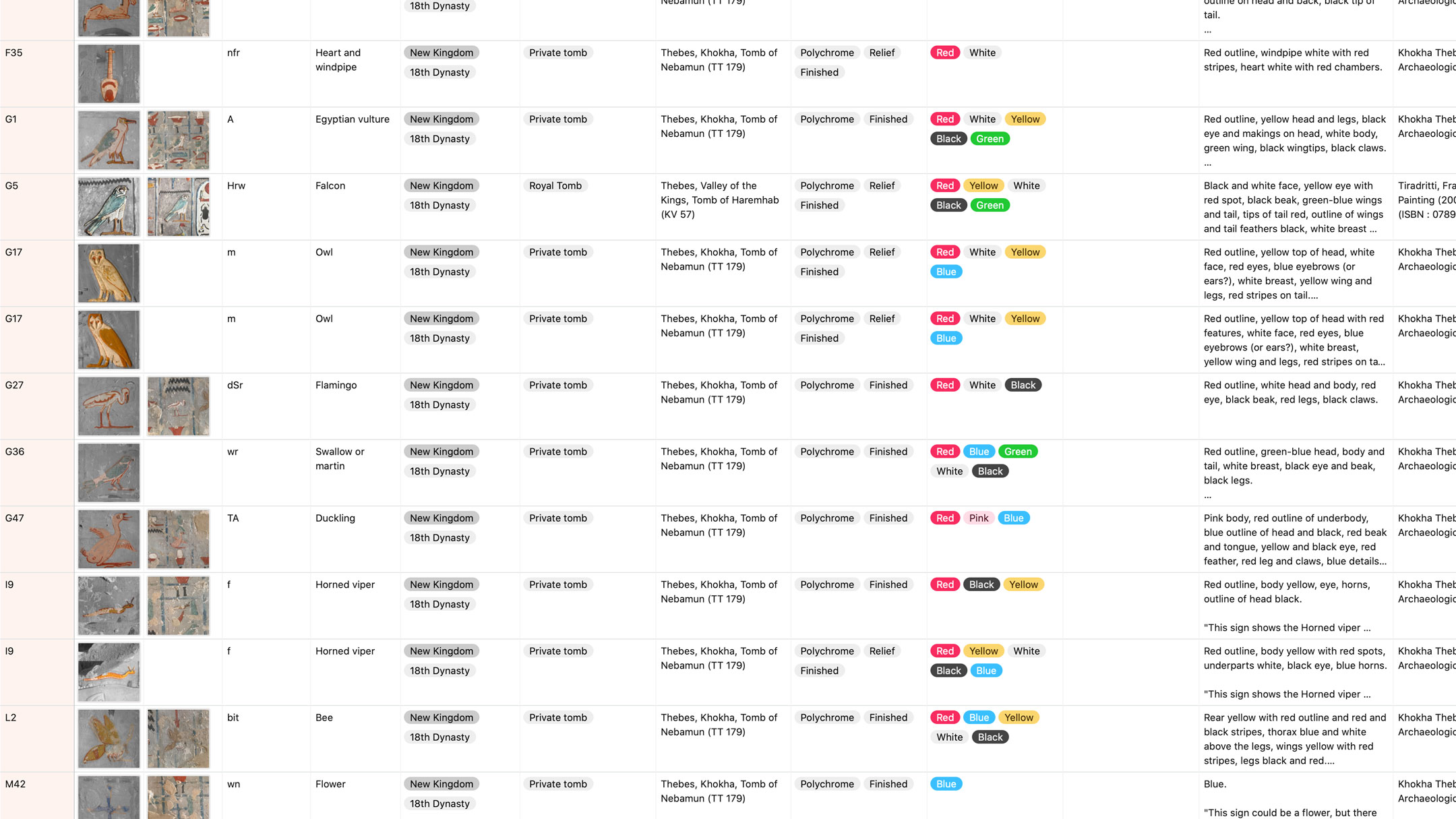
List view of the Painted Hieroglyphs sample catalog accessible through our AirTable software
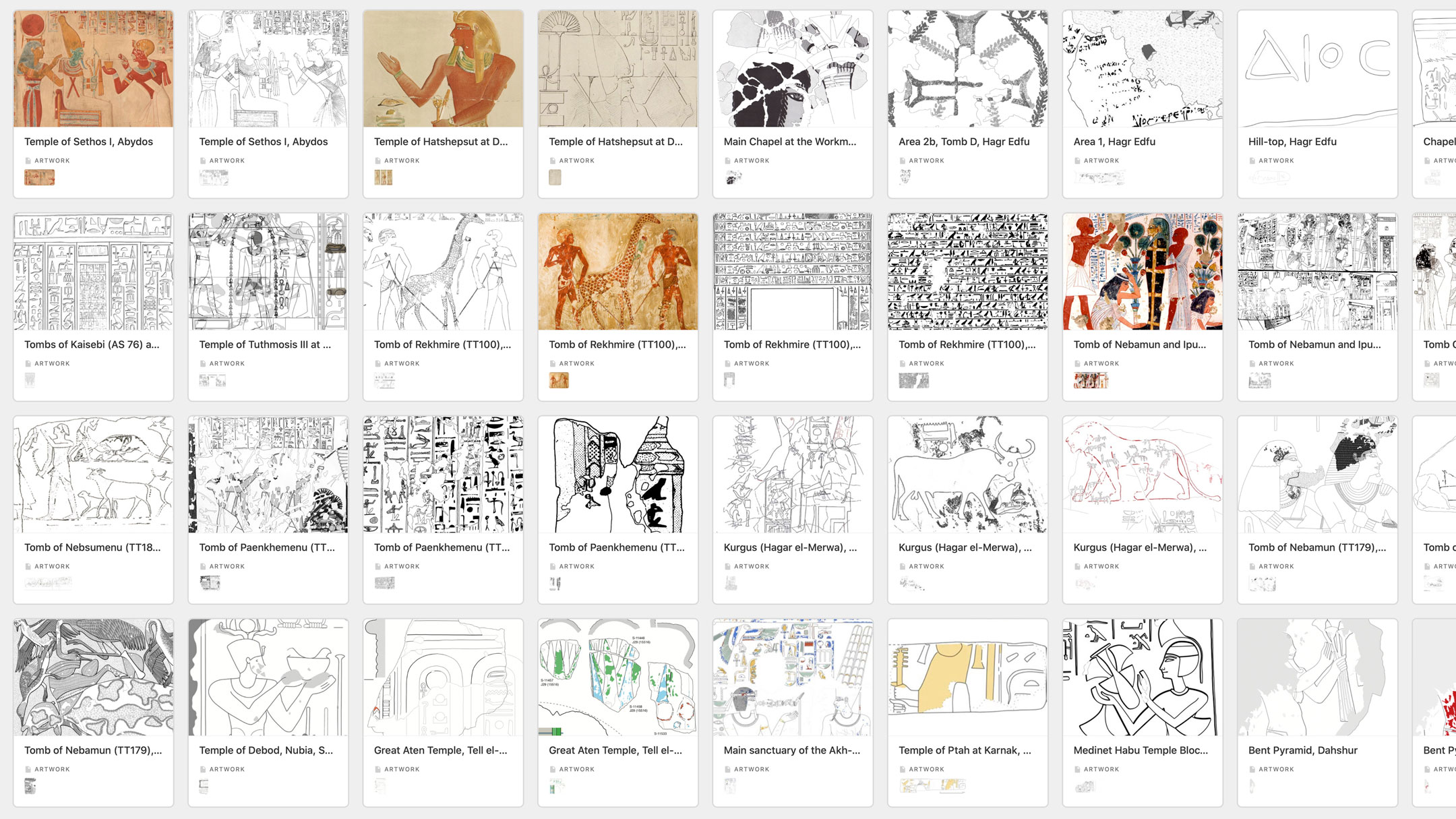
Gallery view of the Visual Documentation sample database containing all the material detailed in our Reading section
And finally, I would like to give you a little sneak peek at the second round of updates we're planning towards the end of the Summer. What we're working on right now will be not one, but two visual databases, directly accessible and searchable through the website, implemented within the Supplementary Material segment. We've been tirelessly collecting and sorting through information regarding exquisitely painted hieroglyph samples and the infinite pool of visual documentation material (aka drawings) that have been published over the past hundred-plus years. We hope that studying an exquisitely detailed hieroglyph, the most basic unit of Egyptian pictorial representation, is going to support your research or epigraphic project by providing you with relevant information on a macro level. On the other hand, being able to revisit, compare, and study the most significant historical and contemporary documentation efforts will enrich your scope of available methods and help you find your epigraphic solutions.
I would like to thank our collaborators Peter Der Manuelian and Marleen De Meyer for their incredible support and faith in what we'd like to achieve with digitalEPIGRAPHY! I would also like to thank each participating colleague who contributed articles on the website! One of our primary mission remains to keep the discussion going in this highly influential segment of Egyptology. Therefore, we'd like to encourage our readers to keep exchanging their views of digital documentation or documentation in general through the channels we provide at digitalEPIGRAPHY. If you have a project with an interesting epigraphic component or have a solution (either digital or traditional) to a documentation issue that you’d like to share with the community, there is no better place than here! To publish your article on our website, please email us at info@digital-epigraphy.com or find us at Chicago House between October 15th - April 15th (The Epigraphic Survey, Corniche el-Nil, Luxor, Egypt).
I would like to express my gratitude to staff members Júlia Schmied for tirelessly finding and presenting new material in our Reading section and Ariel Singer for being our social media ambassador towards the Oriental Institute. Last but not least, I would like to thank the architects of this beautiful website, Groteszk Kreatív Társulat, for providing a home for all things related to documenting ancient Egypt.
Krisztián Vértes
Egyptologist, Senior Artist at the Epigraphic Survey
of the Oriental Institute, University of Chicago



0 comment(s)
Leave a comment(We'll keep your email address private)